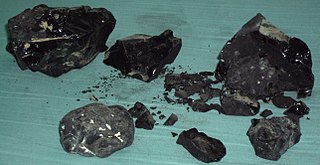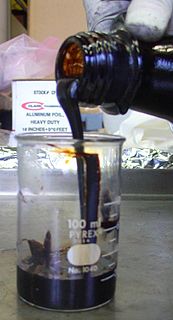Notes
This article includes a list of references, related reading or external links, but its sources remain unclear because it lacks inline citations .(July 2013) |
Bituminous limestone is limestone impregnated and sometimes deeply colored with bituminous matter derived from the decomposition of animal and plant remains entombed within the mass or in its vicinity.
The amount of bituminous matter or asphalt in the pores of the rock is sometimes sufficient to permit the material being used for asphalt pavements after simply powdering and heating it. Still better results are obtained by mixing it with bituminous sandstone.
In the United States, bituminous limestone has been found in Oklahoma, Texas, and Utah. Much bituminous limestone was also mined in Germany, Switzerland, and France, from where large quantities of it were exported to the United States.
This article includes a list of references, related reading or external links, but its sources remain unclear because it lacks inline citations .(July 2013) |

Asphalt, also known as bitumen, is a sticky, black, highly viscous liquid or semi-solid form of petroleum. It may be found in natural deposits or may be a refined product, and is classed as a pitch. Before the 20th century, the term asphaltum was also used. The word is derived from the Ancient Greek ἄσφαλτος ásphaltos. The largest natural deposit of asphalt in the world, estimated to contain 10 million tons, is the Pitch Lake located in La Brea in southwest Trinidad, within the Siparia Regional Corporation.

Bituminous coal, or black coal, is a type of coal containing a tar-like substance called bitumen or asphalt. Its coloration can be black or sometimes dark brown; often there are well-defined bands of bright and dull material within the seams. It is typically hard but friable. Its quality is ranked higher than lignite and sub-bituminous coal, but lesser than anthracite. It is the most abundant rank of coal, with deposits found around the world, often in rocks of Carboniferous age. Bituminous coal is formed from sub-bituminous coal that is buried deeply enough to be heated to 85 °C (185 °F) or higher.
Tarmacadam is a road surfacing material made by combining crushed stone, tar, and sand, patented by Welsh inventor Edgar Purnell Hooley in 1902. It is a more durable and dust-free enhancement of simple compacted stone macadam surfaces invented by Scottish engineer John Loudon McAdam in the early 1800s.

Anthracite, also known as hard coal, black coal, etc. is a hard, compact variety of coal that has a submetallic luster. It has the highest carbon content, the fewest impurities, and the highest energy density of all types of coal and is the highest ranking of coals.

A road surface, or pavement, is the durable surface material laid down on an area intended to sustain vehicular or foot traffic, such as a road or walkway. In the past, gravel road surfaces, cobblestone and granite setts were extensively used, but these have mostly been replaced by asphalt or concrete laid on a compacted base course. Asphalt mixtures have been used in pavement construction since the beginning of the 20th century and are of two types: metalled (hard-surfaced) and unmetalled roads. Metalled roadways are made to sustain vehicular load and so are usually made on frequently used roads. Unmetalled roads, also known as gravel roads, are rough and can sustain less weight. Road surfaces are frequently marked to guide traffic.

Asphalt concrete is a composite material commonly used to surface roads, parking lots, airports, and the core of embankment dams. Asphalt mixtures have been used in pavement construction since the beginning of the twentieth century. It consists of mineral aggregate bound together with asphalt, laid in layers, and compacted. The process was refined and enhanced by Belgian-American inventor Edward De Smedt.
The American Association of State Highway and Transportation Officials (AASHTO) is a standards setting body which publishes specifications, test protocols, and guidelines that are used in highway design and construction throughout the United States. Despite its name, the association represents not only highways but air, rail, water, and public transportation as well.
Glassphalt or glasphalt is a variety of asphalt that uses crushed glass. It has been used as an alternative to conventional bituminous asphalt pavement since the early 1970s. Glassphalt must be properly mixed and placed if it is to meet roadway pavement standards, requiring some modifications to generally accepted asphalt procedures.

Tar is a dark brown or black viscous liquid of hydrocarbons and free carbon, obtained from a wide variety of organic materials through destructive distillation. Tar can be produced from coal, wood, petroleum, or peat.
Sub-bituminous coal is a lower grade of coal that contains 35–45% carbon. The properties of this type are between those of lignite, the lowest grade of coal, and those of bituminous coal, the second-highest grade of coal. Sub-bituminous coal is primarily used as a fuel for steam-electric power generation.

Chipseal is a pavement surface treatment that combines one or more layer(s) of asphalt with one or more layer(s) of fine aggregate. In the United States, chipseals are typically used on rural roads carrying lower traffic volumes, and the process is often referred to as asphaltic surface treatment. This type of surface has a variety of other names including tar-seal or tarseal, tar and chip, sprayed seal or surface dressing.

The Osage Plains are a physiographic section of the larger Central Lowland province, which in turn is part of the larger Interior Plains physiographic division. The area is sometimes called the Lower Plains, North Central Plains,or Rolling Plains. The Osage Plains, covering west-central Missouri, the southeastern third of Kansas, most of central Oklahoma, and extending into north-central Texas, is the southernmost of three tallgrass prairie physiographic areas. It grades into savanna and woodland to the east and south, and into shorter, mixed-grass prairie to the west. The Osage Plains consist of three subregions. The Osage Plains proper occupy the northeast segment. Although sharply demarcated from the Ozark uplift, the plains are nonetheless a transitional area across which the boundary between prairie and woodland has shifted over time. In the central portion of the physiographic area lies the second subregion, the Flint Hills, commonly called "the Osage" in Oklahoma. This large remnant core of native tallgrass prairie is a rocky rolling terrain that runs from north to south across Kansas and extends into Oklahoma. To the west and south of these hills are the Blackland Prairies and Cross Timbers. This vegetatively complex region of intermixed prairie and scrubby juniper-mesquite woodland extends into north-central Texas. Bluestem prairies and oak-dominated savannas and woodlands characterize the natural vegetation in the Cross Timbers. Much of the area has been converted to agriculture, although expanses of oak forest and woodland are still scattered throughout the eastern portion of the subregion.
Keystone Bituminous Coal Ass'n v. DeBenedictis, 480 U.S. 470 (1987), is a United States Supreme Court case interpreting the Fifth Amendment's Takings Clause. In this case, the court upheld a Pennsylvania statute which limited coal mining causing damage to buildings, dwellings, and cemeteries through subsidence.

Mummia, mumia, or originally mummy referred to several different preparations in the history of medicine, from "mineral pitch" to "powdered human mummies". It originated from Arabic mūmiyā "a type of resinous bitumen found in Western Asia and used curatively" in traditional Islamic medicine, which was translated as pissasphaltus in ancient Greek medicine. In medieval European medicine, mūmiyā "bitumen" was transliterated into Latin as mumia meaning both "a bituminous medicine from Persia" and "mummy". Merchants in apothecaries dispensed expensive mummia bitumen, which was thought to be an effective cure-all for many ailments. It was also used as an aphrodisiac. Beginning around the 12th century when supplies of imported natural bitumen ran short, mummia was misinterpreted as "mummy", and the word's meaning expanded to "a black resinous exudate scraped out from embalmed Egyptian mummies". This began a period of lucrative trade between Egypt and Europe, and suppliers substituted rare mummia exudate with entire mummies, either embalmed or desiccated. After Egypt banned the shipment of mummia in the 16th century, unscrupulous European apothecaries began to sell fraudulent mummia prepared by embalming and desiccating fresh corpses. During the Renaissance, scholars proved that translating bituminous mummia as mummy was a mistake, and physicians stopped prescribing the ineffective drug. Lastly, artists in the 17–19th centuries used ground up mummies to tint a popular oil-paint called mummy brown.

Crushed stone or angular rock is a form of construction aggregate, typically produced by mining a suitable rock deposit and breaking the removed rock down to the desired size using crushers. It is distinct from naturally occurring gravel, which is produced by natural processes of weathering and erosion and typically has a more rounded shape.

Bituminous waterproofing systems are designed to protect residential and commercial buildings. Bitumen is a mixed substance made up of organic liquids that are highly sticky, viscous, and waterproof. These systems are sometimes used to construct roofs, in the form of roofing felt or roll roofing products.
The wearing course is the upper layer in roadway, airfield, and dockyard construction. The term 'surface course' is sometimes used, however this term is slightly different as it can be used to describe very thin surface layers such as chip seal. In rigid pavements the upper layer is a portland cement concrete slab. In flexible pavements, the upper layer consists of asphalt concrete, that is a construction aggregate with a bituminous binder. The wearing course is typically placed on the binder course which is then laid on the base course, which is normally placed on the subbase, which rests on the subgrade. There are various different types of flexible pavement wearing course, suitable for different situations.

Pyrobitumen is a type of solid, amorphous organic matter. Pyrobitumen is mostly insoluble in carbon disulfide and other organic solvents as a result of molecular cross-linking, which renders previously soluble organic matter insoluble. Not all solid bitumens are pyrobitumens, in that some solid bitumens are soluble in common organic solvents, including CS
2, dichloromethane, and benzene-methanol mixtures.
Leitch Manufacturing Co. v. Barber Co., 302 U.S. 458 (1938), is a 1938 decision of the United States Supreme Court extending the tie-in patent misuse doctrine to cases in which the patentee does not use an explicit tie-in license but instead relies on grants of implied licenses to only those who buy a necessary supply from it.